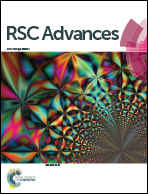Ternary In2S3/In2O3 heterostructures and their cathodoluminescence†
Abstract
Nanoscale semiconductor heterostructures with superior crystal quality, large surface area and designed interfaces provide more opportunities for building high-performance optoelectronic nanodevices and harvesting clean energy. In this work, we report the rational synthesis of In2S3/In2O3 heterostructures through a two-channel chemical vapor deposition (CVD) process. The In2S3/In2O3 heterostructures feature a bundle-like morphology with In2S3 nanowires covering randomly distributed In2O3 nanoparticles. High-resolution transmission electron microscopy (HRTEM) analysis on the In2S3/In2O3 heterostructures finds that both In2S3 nanowires and In2O3 nanoparticles show a crystalline nature, but the lattice matching between the two crystal domains is not observed at the interface, implying that the heterostructure is formed via a simple physical adsorption. Cathodoluminescence (CL) studies on In2S3/In2O3 heterostructures indicate that the as-synthesized heterostructures have a broad emission in the range of 400–950 nm, covering the whole visible light spectrum from violet to infrared. Finally, the formation process of In2S3/In2O3 heterostructures and their optical emission behaviors are discussed based on detailed structural analyses.


 Please wait while we load your content...
Please wait while we load your content...